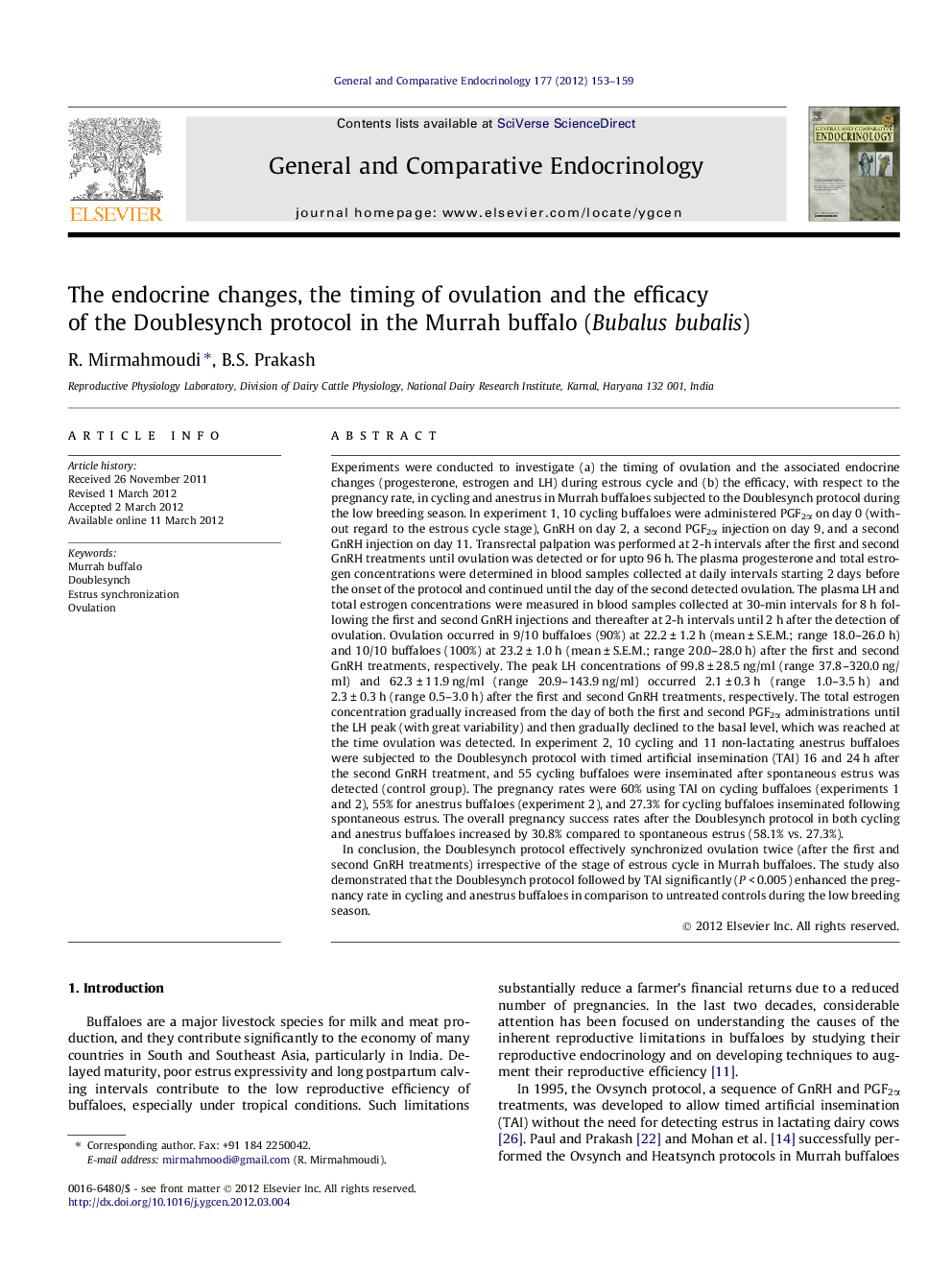| کد مقاله | کد نشریه | سال انتشار | مقاله انگلیسی | نسخه تمام متن |
|---|---|---|---|---|
| 2800525 | 1156112 | 2012 | 7 صفحه PDF | دانلود رایگان |

Experiments were conducted to investigate (a) the timing of ovulation and the associated endocrine changes (progesterone, estrogen and LH) during estrous cycle and (b) the efficacy, with respect to the pregnancy rate, in cycling and anestrus in Murrah buffaloes subjected to the Doublesynch protocol during the low breeding season. In experiment 1, 10 cycling buffaloes were administered PGF2α on day 0 (without regard to the estrous cycle stage), GnRH on day 2, a second PGF2α injection on day 9, and a second GnRH injection on day 11. Transrectal palpation was performed at 2-h intervals after the first and second GnRH treatments until ovulation was detected or for upto 96 h. The plasma progesterone and total estrogen concentrations were determined in blood samples collected at daily intervals starting 2 days before the onset of the protocol and continued until the day of the second detected ovulation. The plasma LH and total estrogen concentrations were measured in blood samples collected at 30-min intervals for 8 h following the first and second GnRH injections and thereafter at 2-h intervals until 2 h after the detection of ovulation. Ovulation occurred in 9/10 buffaloes (90%) at 22.2 ± 1.2 h (mean ± S.E.M.; range 18.0–26.0 h) and 10/10 buffaloes (100%) at 23.2 ± 1.0 h (mean ± S.E.M.; range 20.0–28.0 h) after the first and second GnRH treatments, respectively. The peak LH concentrations of 99.8 ± 28.5 ng/ml (range 37.8–320.0 ng/ml) and 62.3 ± 11.9 ng/ml (range 20.9–143.9 ng/ml) occurred 2.1 ± 0.3 h (range 1.0–3.5 h) and 2.3 ± 0.3 h (range 0.5–3.0 h) after the first and second GnRH treatments, respectively. The total estrogen concentration gradually increased from the day of both the first and second PGF2α administrations until the LH peak (with great variability) and then gradually declined to the basal level, which was reached at the time ovulation was detected. In experiment 2, 10 cycling and 11 non-lactating anestrus buffaloes were subjected to the Doublesynch protocol with timed artificial insemination (TAI) 16 and 24 h after the second GnRH treatment, and 55 cycling buffaloes were inseminated after spontaneous estrus was detected (control group). The pregnancy rates were 60% using TAI on cycling buffaloes (experiments 1 and 2), 55% for anestrus buffaloes (experiment 2), and 27.3% for cycling buffaloes inseminated following spontaneous estrus. The overall pregnancy success rates after the Doublesynch protocol in both cycling and anestrus buffaloes increased by 30.8% compared to spontaneous estrus (58.1% vs. 27.3%).In conclusion, the Doublesynch protocol effectively synchronized ovulation twice (after the first and second GnRH treatments) irrespective of the stage of estrous cycle in Murrah buffaloes. The study also demonstrated that the Doublesynch protocol followed by TAI significantly (P < 0.005) enhanced the pregnancy rate in cycling and anestrus buffaloes in comparison to untreated controls during the low breeding season.
► Doublesynch synchronized ovulation twice and resulted in satisfactory pregnancy.
► Endocrine changes associated with Doublesynch were studied.
► Doublesynch protocol can be efficient in anestrus buffaloes.
Journal: General and Comparative Endocrinology - Volume 177, Issue 1, 15 May 2012, Pages 153–159